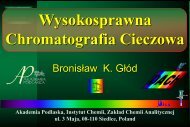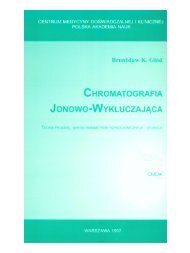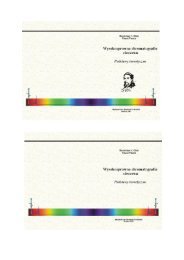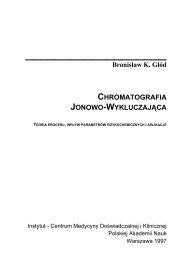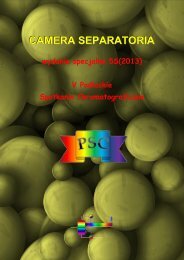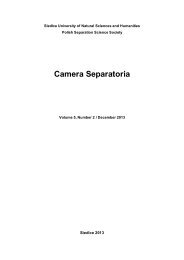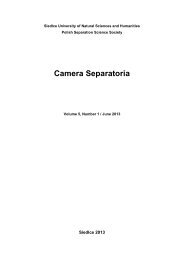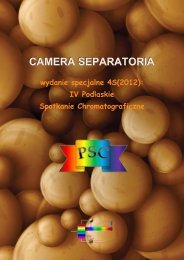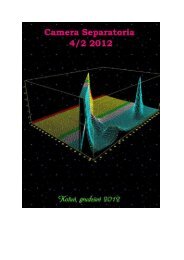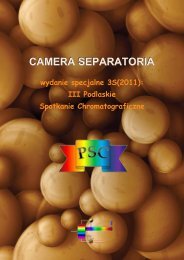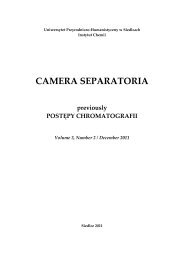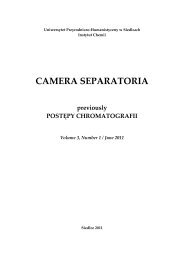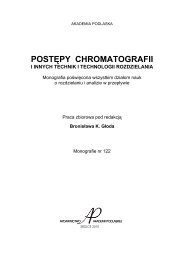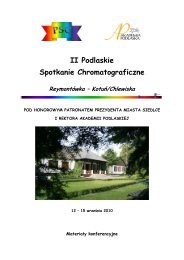CamSep 4 1
Create successful ePaper yourself
Turn your PDF publications into a flip-book with our unique Google optimized e-Paper software.
Zastosowanie wybranych innowacyjnych technik służących do izolacji…<br />
53<br />
poprzez membranę do fazy ciekłej HF-LPME. Eliminacja lub redukcja ilości<br />
rozpuszczalników używanych podczas etapu przygotowania próbki niesie ze<br />
sobą wiele korzyści, między innymi: oszczędności ekonomiczne związane z<br />
zakupem i utylizacją rozpuszczalników, mniejsze obciążenie środowiska<br />
toksycznymi rozpuszczalnikami oraz zmniejszenie ekspozycji pracowników<br />
laboratoryjnych na kontakt z trującymi substancjami. Omówione w niniejszej<br />
pracy techniki ekstrakcyjne posiadają rozwiązania technologiczne umożliwiające<br />
ich automatyzację, łącznie z techniką HF-LPME, której automatyzacji<br />
sprostał zespół badawczy pod kierownictwem prof. Pawliszyna [49].<br />
Techniki te pozwalają także na oznaczanie szerokiej gamy analitów występujących<br />
na niskich poziomach stężeń przy zastosowaniu jednej procedury<br />
analitycznej. W pracy przedstawiono podstawowe informacje, dotyczące<br />
zastosowania technik ekstrakcji MIP-SPE, SPME, SBSE i HF-LPME do<br />
oznaczania pozostałości farmaceutyków w próbkach środowiskowych. Ze<br />
względu na aspekt ekotoksykologiczny i ekonomiczny techniki te stanowią<br />
interesującą alternatywę dla tradycyjnych metod ekstrakcji.<br />
Summary<br />
An important step in determination of pharmaceutical residues in environmental<br />
samples is the selection of a suitable extraction method in order<br />
to isolate and enrich analytes. Traditional methods of sample preparation,<br />
such as LLE or SPE, have many drawbacks including: using large volumes<br />
of samples and toxic solvents, being labor- and time-consuming, expensive<br />
and environmentally hazardous. Recent improvements in the sample preparation<br />
methods not only led to the development of selective extraction methods<br />
like Molecularly Imprinted Solid-Phase Extraction (MIP-SPE), but also<br />
enabled the miniaturization of the apparatus for conducting the sample<br />
preparation process which due to minimal solvent consumption are environmentally<br />
friendly. An example of such solutions is the technique of Solid-<br />
Phase Microextraction, Stir Bar Sorptive Extraction or Hollow-Fiber Liquid<br />
Phase Microextraction. Elimination or reduction of the usage of solvents<br />
brings many benefits including: the economic savings associated with the<br />
purchase and disposal of solvents, reduced pollution with toxic solvents and<br />
exposure of laboratory and diminished exposure of laboratory workers to<br />
poisonous substances. Extraction techniques discussed in this paper are<br />
easy to automate, including HF-LPME, automation of which met the research<br />
team led by prof. Pawliszyn [49]. These techniques also allow the<br />
determination of a wide range of analytes presented at low concentration<br />
levels using a single analytical procedure. The paper presents basic information<br />
on the application of MIP-SPE, SPME, SBSE and HF-LPME extraction<br />
techniques for the determination of pharmaceutical residues in environmental<br />
samples. Due to the economic and ecotoxicological aspects these<br />
techniques are an interesting alternative to conventional extraction methods.<br />
Vol. 4, No 1/2012<br />
Camera Separatoria




